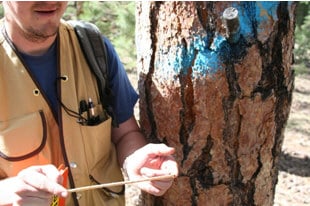There’s more fall-out from the Forest Service’s questionable decision to award a massive 300,000 acre timber harvesting contract as part of the Four Forests Restoration Initiative (4FRI) in Arizona to an under-the-radar Montana timber corporation represented by a retired Forest Service official. The 4FRI is a showcase forest restoration project for the Obama administration under what’s known as “the Collaborative Forest Landscape Restoration Act” and program. Late last Friday, the Center for Biological Diversity sent out this press release.
Tommie Cline Martin, County Supervisor for Gila County, Arizona and a member of the 4FRI, had this to say.
“In my opinion, the Contract that was selected is bogus in several ways: If in fact, an agency insider that was involved in setting policy and advising potential contractors in the process and knew the particulars of the other bidding proposals, then “retired” and helped craft the winning bid is true, this is a perversion of our public trust at the highest level.
Meanwhile, yesterday the Grand Canyon Trust – a founding member of the 4FRI – issued this press release, which among other things said:
[W]e were shocked – and to honest – extremely disappointed that the Forest Service did not choose Arizona Forest Restoration Products (AZFRP) as the contractor responsible for implementing 4FRI treatments over the next decade….AZFRP did not receive the 4FRI contract. Pioneer Associates [from Montana] did. We, and the rest of the northern Arizona community, know almost nothing about the rationale for this decision, and know even less about Pioneer Associates. Some of what we do know is not at all encouraging. Pioneer Associates offered $10 million less than did AZFRP in the bidding process – a sum that would significantly address the critical shortfall in funding currently faced by 4FRI….We at the the Grand Canyon Trust find the recent contracting decision made by the Forest Service extremely problematic and worrisome….
We believe that the Forest Service should, for the sake of transparency, release all information regarding the decision-making process and rationale underlying the contract decision. Similarly, we believe that Pioneer Associates should follow the transparency lead modeled by AZFRP and share, in detail, their business model, implementation strategies, and plans for collaboration. Finally, we believe that an independent and transparent review of the bidding and contract award decision-making process is warranted and should be conducted with all due haste.
Yesterday also saw this hard-hitting editorial from the local newspaper, the Payson Roundup under the title, “We have this terrible, sinking feeling that the Forest Service has done it again” below are some snips from the editorial:
Last week the Forest Service somehow managed to turn the most hopeful and visionary consensus on how we can save our forests and our communities into yet another muddled controversy….So after all that preparation, study, waiting and hope — the Forest Service announced its choice: Pioneer Forest Products — an out-of-state [Montana] wood products company. The company plans to partner with Marlin Johnson, formerly the chief Forest Service logging industry supervisor in the Southwest.
The choice proved instantly controversial, mostly because Johnson spent years battling the very environmental groups whose agreement made the 4-FRI approach so promising. Johnson and groups like the Centers for Biological Diversity fought one another to a deadlock, largely over whether the Forest Service should let the timber companies continue to cut a large share of the remaining old-growth trees.
Even conservative, pro-industry experts like Gila County Supervisor Tommie Martin have expressed concern about the choice, although they have focused on other elements of the contract — like the assumption that Pioneer can make a go of using a lot of the brush and small trees in a relatively untested process for making diesel fuel from wood products….
Now, we hope we’re wrong. We hope that the Centers for Biological Diversity is overreacting when they condemned as ‘cronyism’ the inclusion of Johnson as a partner with a company he used to regulate….But we have to admit, we’re unnerved by the immediate outbreak of controversy and the Forest Service’s stubborn refusal to accept the advice of local officials, conservationists and other stakeholders. Other bidders seemed to offer a much closer working relationship with those groups at a seemingly lower cost to the taxpayers.
We hope it blows over. We hope the Forest Service and Pioneer find a way to quickly reassure the critics, who have worked so hard and so long to achieve the agreement that this choice of contractors threatens to unravel. But we’d certainly feel better if this didn’t feel so familiar — and if we could put out of our minds the unnerving recollection that it was the Forest Service’s cozy and short-sighted relationship with industry that got us into this mess in the first place.”






